A woman may wear many hats: caregiver, meal provider, breadwinner, fitness extraordinaire, dog walker, advice giver…and often many of these simultaneously! Since a woman’s job is never done, she must put her own health first so that she can be there for all who depend on her. Here, we cover how natural products fit into all aspects of a woman’s life, be it for menstrual, fertility, menopause or breast support.
The Power of Probiotics
We often think of probiotics for digestive health, but they play a valuable role in women’s health. “In fact, when it comes to urinary tract and vaginal health, there should be two staple ingredients in every woman’s medicine cabinet (or fridge, in this case) and those ingredients are probiotics and cranberry,” believes Trisha Sugarek MacDonald, B.S., M.S., director of research and development and national educator at Bluebonnet Nutrition Corporation, Sugar Land, TX.
First, many women are faced with several 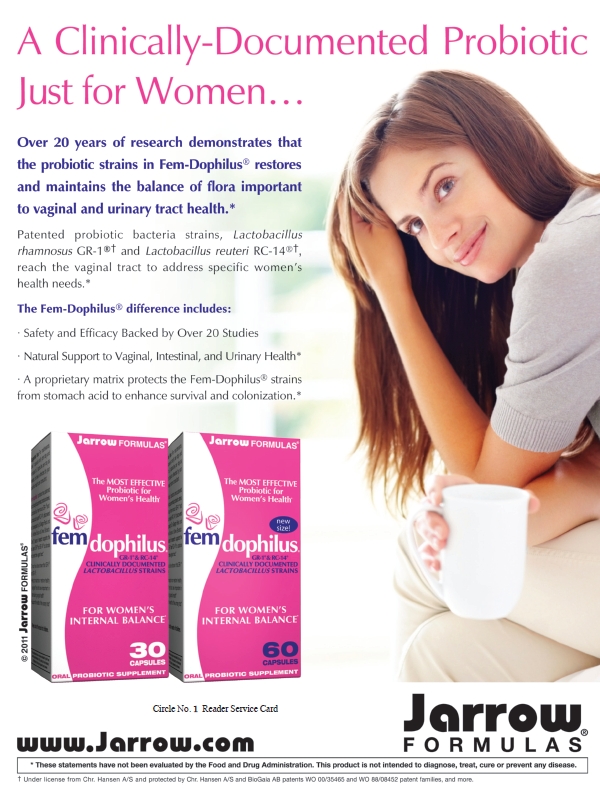 urinary tract infections each year, and cranberries may help prevent bacterial adhesion in this area (see this month’s urology feature for more).
urinary tract infections each year, and cranberries may help prevent bacterial adhesion in this area (see this month’s urology feature for more).
Probiotics can also positively impact vaginal health. “The naturally occurring vaginal flora plays a role in maintaining proper pH and microorganism balance. Some strains have more research for women’s health than others,” states Angelica S. Vrablic, Ph.D., manager of nutrition research at Solgar, Leonia, NJ.
In fact, the vagina houses numerous microbes, with lactobacilli being the most common in healthy women. Lactobacilli can become depleted when the balance changes rapidly (for reasons like hormonal changes, poor hygiene or taking certain medications) and an infection can develop (1). For this reason, Vrablic says lactic acid- producing strains may help maintain proper vaginal pH.
Period Pointers
Many women feel it’s a bit of an inconvenience when “Aunt Flo” makes her monthly appearance. But some women, despite the jokes, are considerably affected by premenstrual syndrome (PMS) with symptoms like cramps, bloating, aches and mood changes.
Prostaglandins cause the menstrual cramps, according to Rebecca Alvandi, vice president of Maxim Hygiene Products, Roslyn Heights, NY. “At the start of a woman’s menstrual flow, the endometrial cells that form the lining of the uterus make large amounts of prostaglandins,” she states. “When the endometrial cells break down during menstruation, the prostaglandins are released. They constrict the blood vessels in the uterus and make its muscle layer contract, causing painful cramps.”
Alvandi goes on to explain that when estrogen levels are lower, there are fewer endometrial cells to break down and, thus, less prostaglandins are released, “which means less cramping! “ Keeping estrogen at healthy levels, she states, is helped with a low-fat, high-fiber diet that includes vegetables, beans, fruits and whole grains. She says the reason why is that when fiber passes through the intestinal tract, it helps estrogen get excreted from the body.
Indeed, Herb Joiner-Bey, N.D., scientific advisor to Barlean’s, Ferndale, WA, makes the point that vegetarian women tend to excrete two to three times more estrogen than other women because of their typically high-fiber diet.
 Sugarek MacDonald backs up the low-fat, high-fiber diet tip with findings from a 1987 study that indicated, “a high-fat diet increased PMS symptoms, while studies that examined B6 and calcium supplementation discovered that they can help manage PMS.”
Sugarek MacDonald backs up the low-fat, high-fiber diet tip with findings from a 1987 study that indicated, “a high-fat diet increased PMS symptoms, while studies that examined B6 and calcium supplementation discovered that they can help manage PMS.”
Joiner-Bey suggests women can “increase sources of water-soluble fiber that binds steroid hormones (such as estrogens) with milled flaxseed and chia seed.”
Unfortunately, too many women aren’t aware of this so ibuprofen and aspirin are standard go-to’s to block the pain. “This is very alarming, because women may be unaware of the very problematic side effects,” says Cheryl Myers, R.N., B.A., integrative health nurse and head of scientific affairs and education for EuroPharma, Inc., Green Bay, WI. “Non-steroidal anti-inflammatory drugs (NSAIDs) such as ibuprofen, naprosyn and aspirin cause over 30,000 deaths a year, and also contribute to increased risk of heart attack.” Meanwhile, women who regularly take acetaminophen may not know they are putting themselves at risk of liver toxicity.
Those interested in a more natural approach will want to consider this fact from Jolie Root, Carlson Labs, Arlington Heights, IL: “Studies have shown that omega-3s from fish oil counteract the production of inflammatory prostaglandin levels to reduce the severity of menstrual cramps. The omega-3s also support fewer fluctuations in mood that may occur before the onset of a woman’s period.”
Lessening inflammation is also the reason why PMS support products may incorporate curcumin. “There is evidence that modulating the inflammatory response prior to the onset of menstruation can greatly mitigate pain and discomfort,” states Myers.
For more specific concerns, Sugarek MacDonald reminds us that just as every woman has different needs, PMS support varies. “Some women may prefer ingredients that work on serotonin levels to improve mood,” she says, suggesting St. John’s wort or pharmaceutical-grade l-tryptophan. Also, amino acids that target alpha-brain waves like l-theanine, she feels, can benefit healthy mood and stress levels.
Likewise, Joiner-Bey links chronic 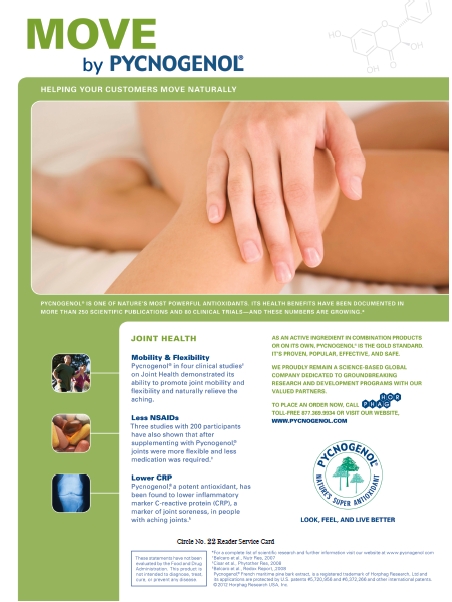 magnesium deficiency to mood instability, nervous hypersensitivity, lowered premenstrual pain threshold and aches/pains. He suggests green foods supplements are the “best supplemental magnesium source.”
magnesium deficiency to mood instability, nervous hypersensitivity, lowered premenstrual pain threshold and aches/pains. He suggests green foods supplements are the “best supplemental magnesium source.”
Meanwhile, dong quai, chaste berry (i.e., vitex) and valerian root have been traditionally used “to balance hormone levels and thus attenuate PMS symptoms,” according to Sugarek MacDonald.
If bloating and water retention (which also may be related to breast soreness during menstruation) are the problems, consider some basic vitamins and minerals. Myers says that a product from her company (P-5-P with Magnesium) is made with a bioactive form of vitamin B6 and chelated magnesium (magnesium glycinate). She explains that since “magnesium is a cofactor in many of vitamin B6’s physiological activities,” the pair helps reduce water retention which supports a healthy menstrual cycle.
Non-inflammatory omega-6 gamma-linolenic acid (GLA, found in borage, evening primrose and black currant oils) is also said to support PMS sufferers. There are several potential reasons, among them being that women with PMS often have trouble converting dietary linoleic acid to GLA. Those deficient in GLA may be over-sensitive to the prolactin hormone, causing breast sensitivity and other issues (2). Irritability, mood and fluid retention may also be benefited from GLA.
Some synergistic herbal combinations may help with PMS support. Says Steven Kravitz, president of Earth’s Bounty and Matrix Health Products, Vancouver, WA, “Most products you take when you’re having difficulties. True Chinese herbalism is about treating the root cause of things naturally to bring you back to homeostasis.” Thus, some herbal combinations (like one from his company) are intended to be taken every day for 90 to 120 days, and then tapered off or stopped. “It’s going to reharmonize your body. Some women take it for 60 days and never do again…with true Chinese herbal medicine, you don’t really take anything long term. That’s a sign that you’re probably taking the wrong thing,” states Kravitz.
Food choices may play a role, too. Kravitz says gluten intolerance is more common in women than in men, for instance. “Many times, these allergic reactions may seem more exacerbated during the menstrual cycle,” he says.
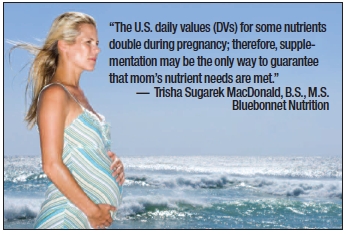 No Leaks, No Worries
No Leaks, No Worries
Women often get into a routine with their menstrual products. They buy their monthly supply of tampons and pads—probably the same brand and style each time—and move on. Well, maybe it’s time to shake things up.
States Amy Spreadborough, marketing manager and brand co-manager at Emerita, Portland, OR, “The average woman will use 12,000 tampons in her lifetime. Many women don’t really think about what’s in their tampons, but they should.”
There are several “new” options out there and women deserve to hear about why they could be a better choice than your regular old drug store product.
First up, we have menstrual cups. These products aren’t new, per se. But they don’t get the same kind of attention as others like tampons and pads.
Menstrual cups makers say there are some clear advantages to this method. Francine Chambers, founder and president of Diva International, Kitchener, ON, Canada, says that women can wear them for longer periods of time than one could use a tampon or pad (up to 12 hours, plus washing and rinsing in between use). The cup’s lifetime is also considerably longer. States Chambers, “Although it varies from woman to woman based on each person’s vaginal pH, we recommend women replace their DivaCup once a year although some women find they need to replace it less frequently....check the cup regularly for discoloration or other signs of deterioration and replace as needed.” This advantage is a clear plus for eco- and cost-conscious customers.
Shoppers may have questions about all this, though. How does the fit work? Doesn’t it leak? What does the cleaning involve?
Chambers says retailers can recommend menstrual 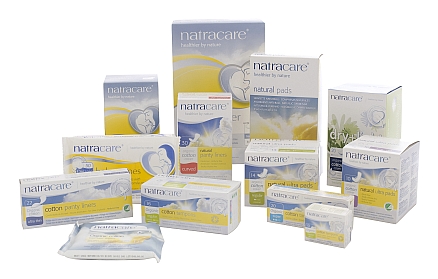 cups with confidence to women of all ages, sizes and lifestyles. Her company offers two sizes of cups: “We recommend Model 1 for women under 30 who have never delivered vaginally and Model 2 for women over 30 and/or who have delivered vaginally or by C-section.”
cups with confidence to women of all ages, sizes and lifestyles. Her company offers two sizes of cups: “We recommend Model 1 for women under 30 who have never delivered vaginally and Model 2 for women over 30 and/or who have delivered vaginally or by C-section.”
As for leaks, Chambers states that once inserted properly, it cannot be felt and does not leak. In fact, the company recently received the endorsement of Julia Wilkinson, a Canadian Olympic swimmer who uses the product.
Cleaning the cup may make some people squeamish, but it just requires a quick wash with mild soap and warm water. When out in public, the process can be even easier. States Chambers, “Simply wash your hands before you go into the stall, empty contents into the toilet and use a tissue to wipe the cup and reinsert.” At the next convenient time, she says, clean the cup with soap and water.
Women may also welcome a switch to organic/natural pads, tampons and liners if they understand the benefits. Theresa White, senior executive officer at Natracare LLC, Greeley, CO, fills us in on some problems with traditional sanitary products. “In sanitary pads, you might expect to find cotton, but what is used to manufacture them is often a combination of plastic-based materials such as polythene, polypropylene and polyacrylate super absorbent gel, surfactants, and chlorine-bleached wood pulp as well as the occasional fragrance preserved with parabens.”
Tampons aren’t any better, since the “cotton” is actually “chlorine-bleached, highly absorbent rayon or a combination of conventionally grown cotton and rayon,” states White. The rayon part is particularly bad because it splinters off and sheds in the vagina, which could lead to infections.
In contrast, Natracare chooses a different technique to avoid fiber loss. States White, “Our tampons are made from 100% organic cotton, a wavy-construction fiber that easily interlocks itself, unlike rayon which, like straight hair, does not entangle itself together.”
Another manufacturer (Emerita) uses a cotton mesh security veil to help keep the tampon fibers in place.
 Another potential problem women rarely think about is the withdrawal string. Dyed pink or blue cords may not seem as cute when you consider the fact that the dye could contain heavy metals, “creating an additional problem for women with metal allergies such as the increasing allergy to nickel,” says White. “The chlorine bleaching process produces an unwanted by-product called dioxin—a substance linked to cancer, endometriosis, low sperm counts and immune system suppression.” Of course, this by-product also comes from any “cottony” material used in a traditional feminine hygiene product.
Another potential problem women rarely think about is the withdrawal string. Dyed pink or blue cords may not seem as cute when you consider the fact that the dye could contain heavy metals, “creating an additional problem for women with metal allergies such as the increasing allergy to nickel,” says White. “The chlorine bleaching process produces an unwanted by-product called dioxin—a substance linked to cancer, endometriosis, low sperm counts and immune system suppression.” Of course, this by-product also comes from any “cottony” material used in a traditional feminine hygiene product.
The true composition of a traditional tampon is something women are definitely not educated about, so retailers can play a role in spreading the correct information. In truth, the information is somewhat veiled since companies aren’t required to list ingredients of tampons, pads and liners. Spreadborough says focus groups used in the development of her company’s line of 100% organic cotton tampons were asked, “What do you think your tampons are made of?” “For almost everyone, the answer involved a moment of awkward silence where it dawned on them that they don’t really know,” states Spreadborough.
What organic and natural companies do differently is to offer the same degree of protection as traditional products, but without the potential health and environmental issues. Alvandi gets into specifics about the benefits: “Products made with organic and natural chlorine-free cotton reduce the risk of irritation, minimize the body and earth’s exposure to dioxins and feel softer. They are also better for the environment because cotton’s a more renewable resource. There is also extensive research showing that the use of cotton tampons is less likely to cause tampon-related cases of the fatal illness toxic shock syndrome (TSS).” Also, the materials tend to be more waste efficient by decomposing easily.
Fertile Ground for Nutrition
When couples trying to conceive are having trouble, they may be willing to try almost anything to become parents. If they are interested in natural products, advise them to talk to a physician, as numerous factors could cause conception difficulties. But with a doctor’s okay, several products can be important tools for couples that want to be parents.
First off is the prenatal multivitamin—yes, even before a pregnancy occurs. “It may seem strange to start taking a prenatal multiple even when you are not pregnant, but the thing is, once you are pregnant, the baby is developing at an exponential rate. As a result, it is important to prepare your body for the baby because it may be too late to supplement once you find out you’re pregnant,” states Sugarek MacDonald.
A classic example of this is folic acid. Most women should consume at least 400 mcg per day before and during early pregnancy. The “before” part is because the B-vitamin helps prevent neural-tube birth defects by as much as 70% (3), which occur very early in pregnancy—often before a pregnancy is known. “Around post-conception Day 28, the neural tube begins to close and appropriate amounts of folic acid are required for it to seal,” says Sugarek MacDonald. A good prenatal may have as much as 600–800 mcg or more.
Folic acid isn’t the only case; there are thiamin, iron, calcium, riboflavin, B12, 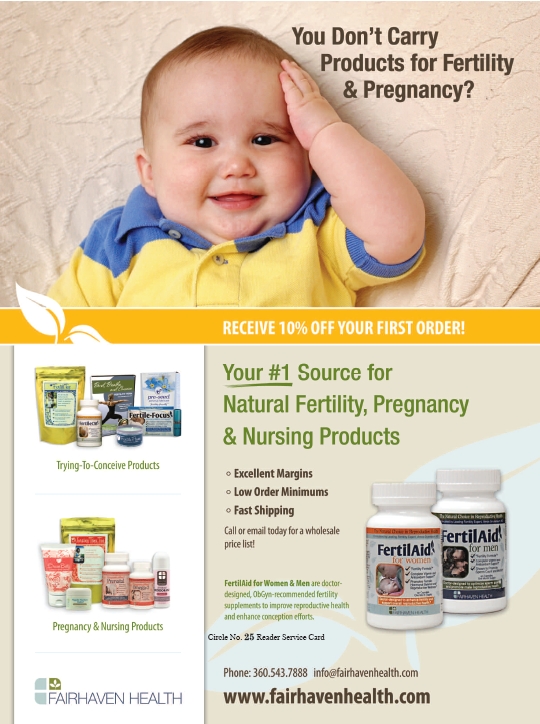 DHA and others that are important in early and throughout pregnancy. “Deficiency or excess of any number of these nutrients can lead to complications during pregnancy for the mother and the developing child,” says Sugarek MacDonald. “The U.S. daily values (DVs) for some nutrients double during pregnancy; therefore, supplementation may be the only way to guarantee that mom’s nutrient needs are met.”
DHA and others that are important in early and throughout pregnancy. “Deficiency or excess of any number of these nutrients can lead to complications during pregnancy for the mother and the developing child,” says Sugarek MacDonald. “The U.S. daily values (DVs) for some nutrients double during pregnancy; therefore, supplementation may be the only way to guarantee that mom’s nutrient needs are met.”
Now, actually facilitating conception can have some nutritional roots. For instance, when polycystic ovary syndrome (PCOS) is the diagnosed cause, there could be “an overabundance of insulin that can cause unhealthy increases in testosterone in women,” states Mark J. Kaylor, vice president of education and research at Mushroom Wisdom, Inc., East Rutherford, NJ. He suggests a particular mushroom fraction for supporting healthy blood sugar levels. “One clinical trial used the Maitake SX fraction and compared it to a leading pharmaceutical commonly used to treat PCOS,” he states. “This study found that two of three women in the study that were trying to conceive and were taking the SX fraction were able to become pregnant whereas none in the pharmaceutical group were able to.”
Myers weighs in, too, on why women who have chronic inflammation may have trouble conceiving. “Chronic inflammation can interfere greatly with fertility, so many practitioners use our CuraMed product, containing clinically studied, high-absorption BCM-95 curcumin in both women and men attempting to conceive a child,” she states.
Other natural products companies take the position that women need to first understand their cycles to best predict when ovulation occurs and a fertile period begins. Since the woman’s body literally warms itself after an egg is released, a woman may be able to anticipate her fertile time by charting her temperature, according to Fairhaven Health (4). Those with irregular cycles may have trouble predicting ovulation and may benefit from a hormone balance-supporting supplement with herbs like chasteberry (4).
Supplements can also support cervical health, since cervical mucus is made during ovulation to protect and nourish sperm while it makes the trip from the uterus and into the fallopian tubes. If women don’t naturally make enough fertile-quality cervical mucus, the sperm may not make it to the fallopian tube where fertilization occurs. Some supplements support this process with amino acids like L-arginine and N-acetyl-cysteine “by hydrating and thinning the cervical mucus and ensuring a proper pH balance for a vaginal environment conducive to conception” (4).
Breast Health: Promising New Research
In the women’s health category, some of the most exciting new research involves breast health. This research has even investigated whether natural compounds support or improve traditional medical interventions like chemotherapy. Other data indicate certain nutrients have anti-tumor properties for breast care.
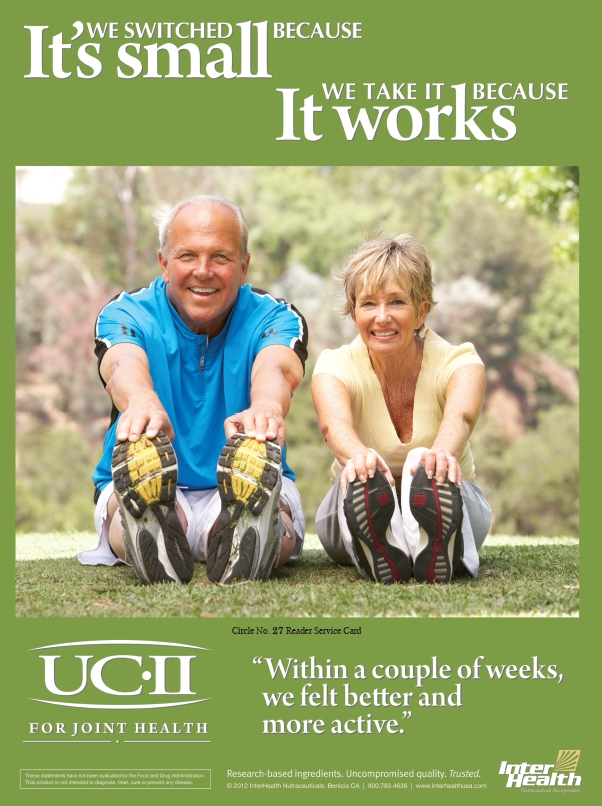 Like all supplements in your store, natural products cannot claim to cure, treat or prevent diseases like cancer. Perhaps one day there will be sufficient evidence to support their use as a medical treatment. But for now, industry members comment on the research strictly to show which nutrients are at the forefront of breast health research.
Like all supplements in your store, natural products cannot claim to cure, treat or prevent diseases like cancer. Perhaps one day there will be sufficient evidence to support their use as a medical treatment. But for now, industry members comment on the research strictly to show which nutrients are at the forefront of breast health research.
Breast cancer typically develops over several years, so anything that influences the breast tissue during that time period (either by helping cells repair damage or perpetuating cancer progression) is being closely examined, says Lise Alschuler, N.D., author, naturopathic oncologist at Naturopathic Specialists LLC, fellow of the American Board of Naturopathic Oncology, host of the Internet radio show Five to Thrive Live (www.w4cs.com) and vice president of quality and education at Emerson Ecologics, Bedford, NH. “Oxidative stress is one influence that disrupts some safeguards in the cells against tumor progression or cancer formation,” she explains. “The process of cell division is a very susceptible time in a cell. If the cell is deficient in antioxidants during this process, division may not occur correctly.” Ultimately, this could lead to chromosome damage and instability that could progress and turn into further mutation or cancers.
Given that antioxidant-deficient cells are more prone to initiating this potentially catastrophic cascade of events, Alschuler says the redox potential of a cell is critical. “The mother of all antioxidants intracellularly is glutathione, so everything is all about restoring reduced glutathione levels,” she states suggesting that vitamin C, vitamin E and selenium are all used to regenerate glutathione. Glutathione, itself, is available in oral supplement form, and Alschuler says this is her top choice for supporting cellular health. She adds there’s good data from Asia that show when you take oral glutathione, you get glutathione effects intracellularly.
Vitamin D is also being studied by cancer research groups. In August, research came to light about this connection based on a small study involving 338 women from affluent Marin County in San Francisco. This area is said to have one of the highest rates of breast cancer in the world (5). The study found that women in this area who were at the highest risk of breast cancer were twice as likely to have a variant vitamin D receptor (which should activate vitamin D in the body). Previous studies ruled out the local environment, family history, use of hormonal therapy and other indicators as factors in the predominance of breast cancer in the area.
Research elsewhere indicates higher vitamin D levels are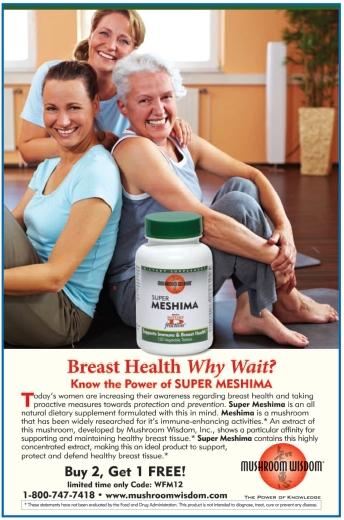 associated with smaller tumor size and better overall survival in breast cancer patients, according to Root. Also this year, researchers took blood samples from 1,800 early-stage breast cancer patients at diagnosis and measured their 25 hydroxyvitamin D levels (6). “The results showed that lower vitamin D levels significantly correlated with larger tumor size at diagnosis,” states Root. “High serum vitamin D (>30ng/mL) at diagnosis was significantly correlated with improved overall survival and disease-specific survival and additionally had a modest effect on disease-free interval, which only became apparent after at least three years.” Postmenopausal patients were found to have the greatest benefit from vitamin D.
associated with smaller tumor size and better overall survival in breast cancer patients, according to Root. Also this year, researchers took blood samples from 1,800 early-stage breast cancer patients at diagnosis and measured their 25 hydroxyvitamin D levels (6). “The results showed that lower vitamin D levels significantly correlated with larger tumor size at diagnosis,” states Root. “High serum vitamin D (>30ng/mL) at diagnosis was significantly correlated with improved overall survival and disease-specific survival and additionally had a modest effect on disease-free interval, which only became apparent after at least three years.” Postmenopausal patients were found to have the greatest benefit from vitamin D.
Other research has focused on immune-supporting mushrooms like Meshima (Phellinus linteus). The target of such trials has been two-fold: supporting conventional interventions and also for immune strengthening and targeted applications. Says Kaylor, “The researchers in one study were so impressed with its use as an adjunct therapy that they suggested lower conventional doses might be possible if the Meshima mushroom extract is used in conjunction.”
Maitake, too, is being studied for its potential as a breast cancer therapy. A team lead by Gabriela Balogh from the Center for Scientific and Technical Investigation in Argentina published a study in April 2011 (7) finding that the Maitake D-Fraction “induced 22 pro-apoptotic genes changes in an in vitro study using an aggressive strain of breast cancer cells,” according to Kaylor.
Alschuler says that extracts of polysaccharide K (PSK, like turkey tail mushroom) and other medicinal mushrooms are considered standard of care in Japan for people receiving chemotherapy or radiation. “There’s been close to 50 human clinical trials that have showed adding medicinal mushrooms to conventional therapies increases response to those therapies,” she states. “They do that primarily by supporting cytotoxic immunity…this is the most important arm of your immune system. Chemotherapy kills the majority of cancer cells, but can’t quite get all of them. It’s important to have an intact well-functioning cytotoxic immunity to get the rest.” And, immune support will help patients ward off infections while undergoing treatment.
 Many medicinal mushrooms are also natural inhibitors of aromatase (i.e., an enzyme in fat cells that converts andrenal steroid hormones into estrogen and testosterone), says Alschuler, which is especially helpful for postmenopausal women who are diagnosed with estrogen receptor-positive breast cancer. In Japan, mushrooms are commonly used for this purpose.
Many medicinal mushrooms are also natural inhibitors of aromatase (i.e., an enzyme in fat cells that converts andrenal steroid hormones into estrogen and testosterone), says Alschuler, which is especially helpful for postmenopausal women who are diagnosed with estrogen receptor-positive breast cancer. In Japan, mushrooms are commonly used for this purpose.
Another herb in the spotlight is turmeric, and Baylor University Medical Center in Dallas, TX is a hub of research on the subject. According to Myers, the group is studying curcumin’s ability to switch on “sleeping genes” that increase the body’s tumor-fighting capability. “They are also looking at curcumin as both a chemo and radiation sensitizer, meaning that in the future, it may be possible to greatly reduce chemo and radiation dosages by augmenting with curcumin,” she says.
Joiner-Bey feels ALA from flaxseed is a nutrient of interest because it was shown in a lab experiment to turn off breast cancer genes, and phytoestrogens (such as flaxseed lignans) reduce the proliferative effects of estrogen. A study done at the University of Toronto, for instance “showed that flax lignans are as effective as Tamoxifen in stopping the adhesion, invasion and migration of human breast cancer cells,” he states. “The study also reported that when lignans are used with Tamoxifen, the drug was even more effective. Others studies have shown that flax lignans not only reduce tumor size, but also the formation of new tumors is reduced.”
But one often overlooked area of research, according to Michael Jeffers, CEO of Helios Corp., Santa Fe Springs, NM, is on breast cancer survivors and menopause support since chemotherapy sometimes induces it. “Many menopause support products—both pharmaceutical and natural—are demonstrated to be unsafe or of questionable safety for women at risk for estrogen-dependent breast cancer,” he states. Jeffers believes soy’s isoflavone, genestein, may not be a good choice for menopausal women (it increased breast cancer rates in rats) and the breast cancer risks associated with other phytoestrogens are still unclear.
Jeffers feels a safer option is his company’s proprietary blend of Angelica gigas Nakai (Korean Angelica), Phlomis umbrosa and Cynanchum wilfordii (EstroG-100), which has undergone overall toxicity, liver toxicity and anti-cancer tests. “In addition to the effective relief it offers for the symptoms of menopause, it also is demonstrated to be completely safe when it comes to breast cancer. It is non-phytoestrogenic, demonstrating no binding affinity to estrogen-receptors,” states Jeffers, adding, “Better yet, in vitro studies indicate it may even provide particular support for breast health.”
He says third-party clinical trials show that the ingredient relieved nine out of 11 menopause symptoms. “In addition, research indicates that it helps with vaginal dryness, bone density and skin health,” says Jeffers.
Menopause Must-Haves
Women needing menopause support have many options. According to Kravitz, “Women pretty much have a static level of hormones for a long time. And then over a period of years, it’s going to go down. Certainly, your body is going to notice that. That’s where seeking natural replacements can really alleviate some symptoms.”
But, some have had both pros and cons associated with them, as Jeffers stated. Take soy, for instance. Interest in soy was piqued by the fact that Japanese women (who eat a lot of soy) have a very low frequency of hot flashes. This extends to breast issues, too, according to Kravitz, adding, “I feel soy definitely has health benefits associated with it.”
But, its effectiveness at alleviating hot flashes has been both supported and called into question in studies, though such discrepancy may be due to small sample sizes and inconsistent methodology (8). Soy is said to have a mild estrogen-like effect, and new research indicates that consuming 54 mg or more of soy isoflavones daily for at least six weeks could reduce hot flashes occurrence by 21% and their severity by 26% more than a placebo (8). Isoflavone supplements with at least 19 mg of genistein “were more than twice as effective at reducing hot flash frequency than lower amounts” (8). Genistein is the main isoflavone in soy foods.
For these positives, companies are standing behind soy. Says J.L. Paes-Leme, Founder/CEO NaturaNectar LLC, Sunrise, FL, “Although soy has been controversial at times, when we decided to introduce it in our menopause-support product, we did it to create the best possible relief for women while using a proven and high-quality soy source, which for us would have to be fermented aglycone isoflavones.”
Paes-Leme explains that aglycone isoflavones absorb better and faster by cell receptors in women than regular glucoside isoflavones (9). His company combines aglycone isoflavones with Brazilian red bee propolis, which he feels offers several benefits to women: “The proprietary calming herbal blend uses herbs that have been traditionally observed to not only produce a calming effect on the women taking them but also to work synergistically with the aglycone isoflavones to relief menopause symptoms.”
Another important menopause-support herb is black cohosh, about which shoppers may also have heard both positives and negatives. Cecile Kehoe, chief operations officer at DreamBrands, Phoenix, AZ, supports the use of black cohosh. She states, “There have been over 19 studies done with this herb and the majority indicates that it does improve menopause-related symptoms.”
According to the Office of Dietary Supplements, “Liver damage has been reported in a few individuals using black cohosh, but millions of people have taken the herb without apparent adverse health effects” (10). Thus, supplement makers feel it is a safe way to support those with hot flashes that don’t have liver disorders.
The National Center for Complementary and Alternative Medicine (NCCAM) is currently sponsoring a rigorous scientific study to find out whether black cohosh can reduce the frequency and intensity of hot flashes and other menopausal symptoms. It will also examine exactly how black cohosh helps in this manner (10).
According to Sugarek MacDonald, some mechanisms of action are already hypothesized. The root contains triterpene glycosides and isoflavones. “One theoretical mechanism of action is that triterpene glycosides influence luteinizing hormone secretions during menopause; therefore, potentially inhibiting hot flashes,” she states.
Given the importance of triterpene glycoside for menopause support, Myers says, “It is extremely important to be an obsessive label-reader, as many prominent black cohosh products have dropped their standardization. This is unfortunate, because the important research on black cohosh was done at a 2.5% triterpene glycoside level. It may be a bit more expensive to make sure the product you select has standardized black cohosh at the level examined in human studies, but efficacy appears to be tied to this standardization.” Her firm combines black cohosh with hop cone extract (which has published studies on reductions in night sweats and hot flashes) and pomegranate.
Another key menopause-support ingredient is dong quai, which includes components like butylidenephthalide, ligustilide and n-butylphthalide. States Sugarek MacDonald, “Ligustilide has notably been used for its ability to attenuate women’s menopausal health issues such as cramping, due to its antispasmodic activity on smooth muscle action.”
Meanwhile, Vrablic believes Thai Kudzu (Pueraria mirifica) should have a place on your shelves. She states, “It has long been used in traditional Chinese health practices, and is gaining popularity as a supplement today.” The March 2007 Vitamin Connection column published in WholeFoods Magazine explained that this herb contains several phytoestrogens including miroestrol, which has specifically been linked to menopause symptom relief.
Kehoe also likes maca root because “it encourages a balance between estrogen and progesterone,” which can be helpful for those with hot flashes, vaginal dryness and decreased sex drive.
Sage, too, may be of help. Eileen Sheets, managing director of Bioforce USA, Ghent, NY says it may help those with hot flashes and night sweats. She says these symptoms may be a result of the way decreased estrogen levels affect the hypothalamus portion of the brain, which “controls temperature, making it think it’s too hot.”
She cites a study finding sage decreased hot flashes by 30% after two weeks and after four weeks, there was a 50% decrease in the other symptoms as well. “When the study ended, the symptoms were still decreasing, so improvement could be expected to continue with use of sage,” she explains.
Pills aren’t the only way to address menopause symptoms. Kehoe suggests that topical natural progesterone cream helps midlife balance, and this includes wild yam-derived progesterone. These products can offer women relief because while estrogen levels drop 40–60% at menopause, “progesterone levels may drop to near zero in some women,” says Kehoe. “Because progesterone is the precursor to so many other steroid hormones, its use can greatly enhance overall hormone balance after menopause.”
And for the vaginal dryness that often occurs midlife due to hormonal changes, natural personal water-based moisturizers and lubricants can help, such as those with vitamin E, calendula and ginseng for tissue support.
Last, natural companies have developed feminine cleansing washes and cloths as a replacement for irritating soaps. “Most soaps contain perfumes and other ingredients that can contribute to irritation,” states Spreadborough. “Our wash is pH-balanced and perfume-free, with calendula, aloe and chamomile for tissue support. It’s formulated to moisturize, as well as cleanse.”
Tell women to be patient with all the aforementioned menopause products. According to Kehoe, “As with most supplements, the studies have been done over several weeks or months. By taking daily herbal extracts, you tend to feel effects within a couple of months. As for progesterone creams, you may feel the effect sooner, maybe within a couple of weeks.” WF
References
1. S. Cribby, M. Taylor and G. Reid, “Vaginal Microbiota and the Use of Probiotics,” Interdisciplinary Perspectives on Infectious Diseases, Volume 2008 (2008), 9 pages.
2. K. Sigurdson, “GLA Every Day Keeps PMS Away,” Bioriginal, www.bioriginal.com/services/files/file_14.pdf, accessed Aug. 31, 2012.
3. March of Dimes, “Folic Acid Keeps You and Your Baby Healthy,” www.marchofdimes.com/pregnancy/folicacid_before.html, accessed Sept. 1, 2012.
4. Fairhaven Health, www.fairhavenhealth.com, accessed Sept. 1, 2012.
5. V. Colliver, “Marin Bread Cancer Linked to Vitamin D Receptor?” San Francisco Chronicle, posted Aug. 8, 2012, www.sfgate.com/health/article/Marin-breast-cancer-linked-to-vitamin-D-3770785.php, accessed Sept. 1, 2012.
6. S. Hatse, et al., “Vitamin D Status at Breast Cancer Diagnosis: Correlation with Tumor Characteristics, Disease Outcome, and Genetic Determinants of Vitamin D Insufficiency,” Carcinogenesis. 33 (7), 1319–1326 (2012).
7. R. Soares, et al., “Maitake (D Fraction) Mushroom Extract Induces Apoptosis in Breast Cancer Cells by BAK-1 Gene Activation,” J. Med. Food. 14 (6), 563–572 (2011).
8. University of Delaware, “Soy and Menopause,” April 4, 2012, www.udel.edu/udaily/2012/apr/melby-soy-menopause-040412.html, accessed Sept. 1, 2012.
9. T. Izumi, et al., “Soy Isoflavone Aglycones Are Absorbed Faster and in Higher Amounts than Their Glucosides in Humans,” J. Nutr. 130 (7), 1695–1699 (2000).
10. “Black Cohosh,” http://ods.od.nih.gov/factsheets/BlackCohosh-HealthProfessional, accessed Sept. 1, 2012.
Published in WholeFoods Magazine, October 2012










